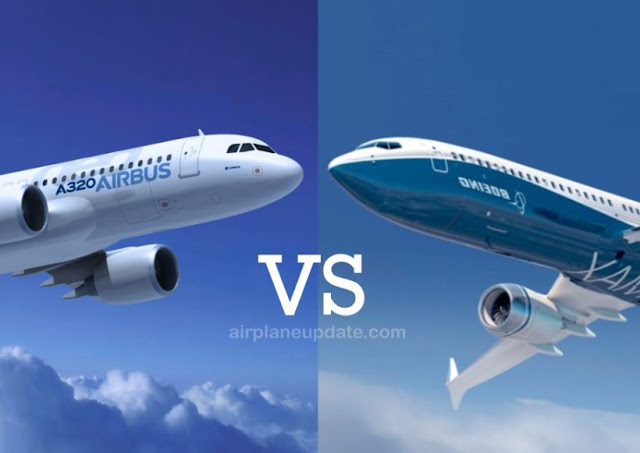
Design of Airbus A320neo vs Boeing 737 MAX
The A320neo
and 737 MAX each plane is come in three variants. Interestingly, the two aircraft
families chose to drop the smallest version of the previous generation (A318
and 737-600). According to Airbus, the A320neo has 95% similarity to the
A320ceo, and comes with two engine options: CFM LEAP-1A and Pratt & Whitney
PW1100G GTF. The latter belongs to the family of Geared Turbofan (GTF) engines
that will power most new generation aircraft, including Bombardier's CSeries,
Embraer's E-Jet E2s, Russian-made Irkut MC-21s, and Mitsubishi Regional
Aircraft (MRJ).
CFM
International will be the sole supplier for Boeing 737 MAX, which will feature
a slightly smaller LEAP-1B. When it started with an older fuselage, and thus
less optimized, Boeing had to invest more in improving aerodynamics to reduce
additional fuel efficiency, including the integration of nacelle wings, the
LEAP engine and the new advanced technology winglets featuring split tips.
Combined, this increase will result in an additional 2% fuel savings provided
by the new engine. Boeing also had to extend the MAX landing gear to
accommodate the larger LEAP-1B fan diameter: 69.4 inches (1.76 m), in contrast
to 61.8 inches (1.56 m) of the CFM56-7B 737NG engine.
Maximum Range of Airbus A320neo vs Boeing 737 MAX
The 737-7 MAX
has a maximum range of 3,350nm (6,204km), while the actual A319neo range (not
advertised) is estimated at 3,650nm (6,759km). After discounting these numbers
with a standard 15% -25% for factors such as fuel reserves, additional payloads
and headwinds, stillair operation envelopes for these two aircraft remain in
the range of 2,500-3,100 nm, comfortably allowing them to open all their missions
with full loads.
The 737-8 MAX
has an estimated maximum range of 3.515nm (6.509 km), while the actual A320neo
range (not advertised) is estimated at around 3,300nm (6,110 km), reversing the
superiority of the range possessed by the A319neo above -7 MAX. Theoretically,
-8 MAX can fly long-haul flights, such as the transatlantic ones from LCC like
Norway (DY), which A320neo cannot do.
Finally, the
737-9 MAX has the same range as -8 MAX, while the actual range (not advertised)
of the A321 is estimated at 3,650nm (6,759 km). Both of them can comfortably
operate all of their missions with full loads. However, the LR A321neo (long
distance) extends the superiority of the A321neo range. The -9 MAX is a limited
performance from ever reaching its full potential.
Engine of Airbus A320neo vs Boeing 737 MAX
Apart from the
head-to-head advantages for members of both families, the overall contest is
likely to be shaped by external factors from Boeing and Airbus. The main one
came on the engine that would hang under the wings of each aircraft, between
CFM LEAP and PW1100 GTF.
CFM has a
major point in supporting it because there is a risk of substantial execution
of the Pratt & Whitney Geared Turbo Fan (GTF), a technology that is more
innovative and thus more unproven. As a small example, look at software issues
and certifications that encourage early A320neo shipments. The LH takes the
first A320neo instead of Qatar Airways (QR) because it can operate it near the
Lufthansa Technik treatment center and attend to all possibilities quickly -
even though the Doha-based operator can't. QR also refused because the GTF
engine had to run idle for three minutes after start-up; until the time frame
passes, the aircraft cannot use its own strength. QR will not board the plane
until the weakness is corrected. And Airbus has paid a penalty.
The broader
point is that there is some risk of execution on GTF, and that has been hinted
at by the market: even though positioning GTF as the preferred platform, CFM
has a market share of 53% in neo alone and (by default) combined market share
of 79%. So in the near future, orders may come to those who have better
availability. This has swung back and forth between Airbus and Boeing over the
past few years, and both manufacturers are competing to add production to their
core single aisle program.
Airbus will
increase the A320 production rate to 50 aircraft per month at the beginning of
2017 and to 60 in 2019. Boeing has committed to 52 aircraft per month with
capacity up to 60 as well. With an uncertain engine situation, actual
availability could be a determining factor in a neo versus MAX contest rather
than a turbine under the wing.








No comments:
Post a Comment